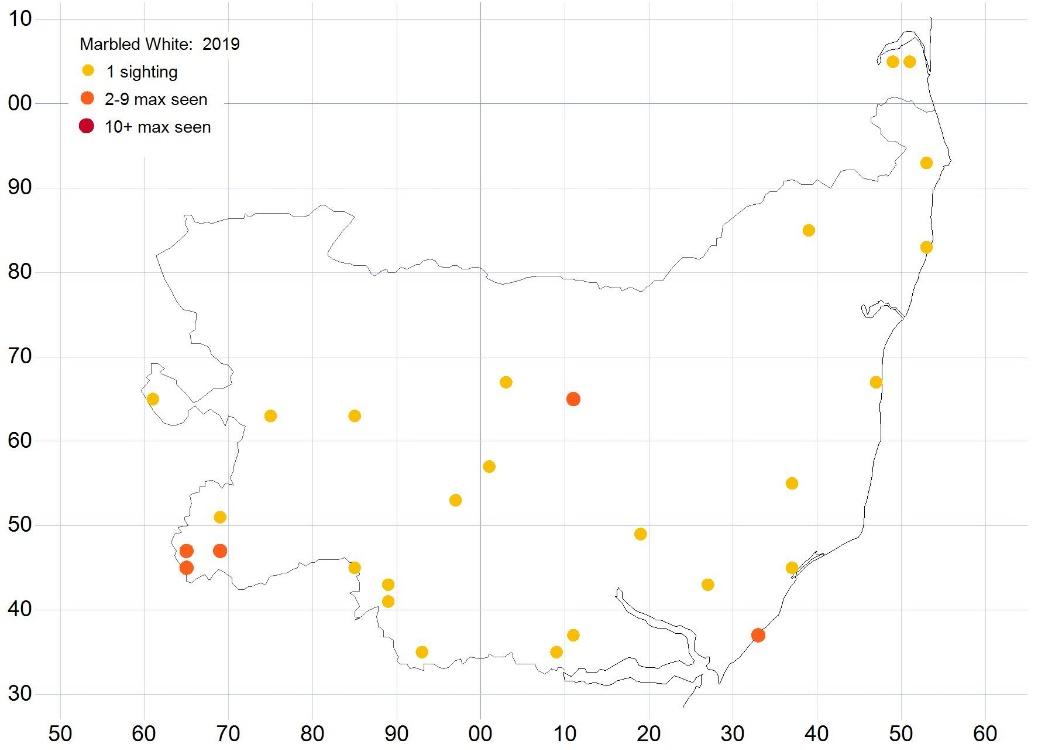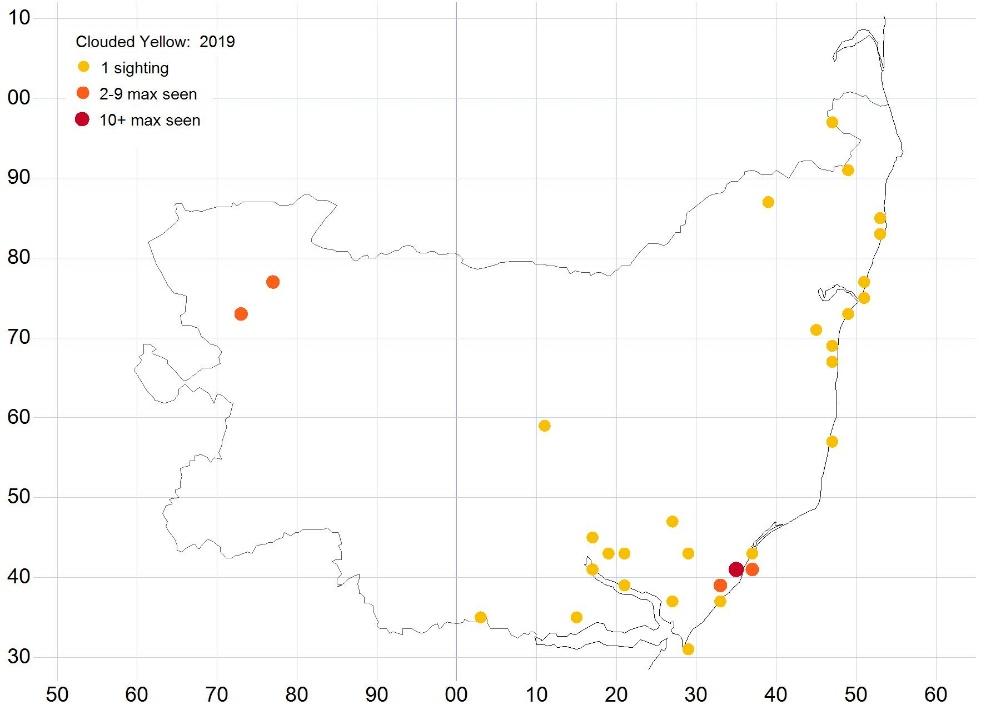
7 minute read
Residents & migrants
northern Scotland and East Anglia were slightly drier than average for the year. The provisional UK sunshine total for 2019 was 1455 hours, which is 106% of the 1981-2010 average. Eastern areas fared best relative to average, getting within the top ten sunniest years for some areas. February was the second sunniest on record for the UK. (www.metoffice.gov.uk)
3. Residents, Winners & Losers
(See Annex A- Scarcity for species seen in Suffolk in 2019). For me, 2019 felt like a rather average butterfly year but I was very interested to read the annual report from the UKBMS which identified 2019 as the 8th best year out of the UKBMS recording series covering 44 years. It was also the best year in this series since 1997, with just over half of species (53%) showing a higher population index compared to 2018. The year promised a Painted Lady invasion and although it was a very good year for this species it wasn’t a classic year and certainly fell short of what we experienced in 2009 (see below 5. Migrants and Rarities). That said, Painted Lady was the fifth most abundant butterfly in Suffolk for the year behind Peacock (4th), Large White (3rd), Red Admiral (2nd) and Small White (1st). Garden favourites Peacock and Small Tortoiseshell both enjoyed year increases from 2018. Of note, numbers of these species recorded from Butterfly Conservation’s Big Butterfly Count increased considerably with Small Tortoiseshell up 167% and Peacock up 235% on 2018 results. Both species also recorded their highest number of records since the Count commenced in its current form in 2010. In Suffolk, to me Small Tortoiseshell remained scarce and disappeared early to hibernation. An interesting paper is available to read on this behaviour, written by Malcolm Hull from the Herts & Middx BC Branch. See link https://hertsmiddx-butterflies. org.uk/SmallTortoiseshells.pdf The warm weather experienced early in the year certainly helped a number of spring species with Brimstone doing particularly well in Suffolk. Nationally, according to the UKBMS report Brimstone enjoyed a “statistically significant positive 10-year UK trend, of 108%”. The long hot summer of 2019 seemed to pay some dividends with many grass loving butterflies enjoying a good year. The three golden skipper species (Essex, Small and Large) all held their own and Meadow Brown and Ringlet showed small increases on 2018. However, despite having a great year in 2018, summer woodland fliers seemed to struggle and both Purple Hairstreak and White-letter Hairstreak saw numbers fall along with those of White Admiral. Both Purple Emperor and Silver- washed Fritillary remained at a similar level to 2018.
Sadly, 2019 was not a great year for some species with Common Blue, Silver-studded Blue and Grayling (see below) all struggling in Suffolk. Disappointingly, these three species also struggled at a national level
4. Early & Late records.
(See Annex B- Suffolk Butterfly Species Earliest and Latest dates up to end 2019). A review of Annex B provides for first and last records reported for each species seen in the year. This information sits alongside the Earliest and Latest dates recorded for each species as county records. Only one new earliest date was achieved in 2019 and this related to a White-letter Hairstreak being seen on 18th May (Sandy Drove, Icknield Way), beating the previous earliest date for this species of 30th May 2015. A Swallowtail sighting on 3rd September became Suffolk’s latest.
Of note, last year’s table contained an error for the earliest date for Orange-tip. This was reported as 16/02/2015 whereas it should have remained at 9th March 2014. That said, Orange-tip was seen later in 2019 with a new latest county date recorded of 8th August and suggests a partial 2nd generation.
5. Migrants and Rarities.
Overall, 2019 was generally poor for migrants in respect of the variety and extreme rarity of species. However, migration was to some extent significant in respect of Painted Lady, Red Admiral and Small White.
Three records were received for Swallowtail-: Burgh Castle on 23rd August, Lower-Ufford, Woodbridge on 25th August and on 3rd September at Woodbridge Airbase site. The Burgh Castle individual is potentially a wanderer from the Norfolk breeding grounds and the Woodbridge sightings could relate to a migrant and could also relate to the same individual.
The year was poor for Clouded Yellow sightings, and the maximum count only reached 10 at East Lane (25-29 August). Very little inland penetration was achieved as can be seen by map below.
Map 2: Distribution of Marbled White, 2019 Map 2: Distribution of Marbled White, 2019
Only a single record was received for Long-tailed Blue, this despite good numbers reported along the south coast of England. It is highly likely that as a species it went unnoticed given its fast flight and restless behaviour. The Suffolk record was at Sizewell on 24th August. It was a particularly good Painted Lady year but far from what was seen back in 2009. The butterfly was widespread throughout the county with three real peaks as shown below in June and August. It was first seen on 16th March and last seen on 9th November. The graph below shows clear peaks in numbers, indicative of arrivals from the continent.
Map 1: Distribution of Clouded Yellow, 2019 Map 1: Distribution of Clouded Yellow, 2019

Of interest, Small White was seen in good numbers at various coastal sites with some immigration and coastal movements witnessed. One significant observation was of an estimated 1000+ Small Whites flying inland along the River Orwell, touching land at Levington on 25th August. Of note, in some of the large influxes, Marbled Whites were also seen possibly suggesting that Small White could act as a carrier for other species dispersal. I personally saw this at Felixstowe Ferry on 13th July where over 500 Small Whites were seen roosting and flying around the hamlet’s gardens and coastal marshes. As the temperature increased, I saw two Marbled Whites flying strongly amongst other Small Whites which were moving along the beach and inland to the River Deben. Several other Marbled Whites were recorded at coastal sites as shown below.
Only a single record was received for Longtailed Blue, this despite good numbers reported along the south coast of England. It is highly likely that as a species it went unnoticed given its fast flight and restless behaviour. The Suffolk record was at Sizewell on 24th August. It was a particularly good Painted Lady year but far from what was seen back in 2009. The butterfly was widespread throughout the county with three real peaks as shown below in June and August. It was first seen on 16th March and last seen on 9th November. The graph below shows clear peaks in numbers, indicative of arrivals Of interest, Small White was seen in good from the continent.numbers at various coastal sites with some immigration and coastal movements witnessed. One significant observation was of an estimated 1000+ Small Whites flying inland along the River Orwell, touching land at Levington on 25th August. Of note, in some of the large influxes, Marbled Whites were also seen possibly suggesting that Small White could act as a carrier for other species dispersal. I personally saw this at Felixstowe Ferry on 13th July where over 500 Small Whites were seen roosting and flying around the hamlet’s gardens and coastal marshes. As the temperature increased, I saw two Marbled Whites flying strongly amongst other Small Whites which were moving along the beach and inland to the River Deben. Several other Marbled Whites were recorded at coastal sites as shown below. Highest counts received were 200+ Felixstowe Ferry on 11th June, 100+ Felixstowe Ferry on 21st June, 100+ East Lane on 2nd August, 100+ Beck Row on 6th August, 175- Martlesham 5 Creek, River Deben on 11th August. The butterfly was seen widely across the county penetrating far inland as shown in the distribution map below.

Map 2: Distribution of Marbled White, 2019
Only a single record was received for Long-tailed Blue, this despite good numbers reported along the south coast of England. It is highly likely that as a species it went unnoticed given its fast flight and restless behaviour. The Suffolk record was at Sizewell on 24th August. It was a particularly good Graph 1: Painted Lady peak dates, 2019Painted Lady year but far from what was seen back in 2009. The butterfly was widespread throughout the county with three real peaks as shown below in June Highest counts received were 200+ Felixstowe Ferry on 11th June, 100+ Felixstowe Ferry on and August. It was first seen on 16th March and last seen on 9th November. The graph below 21st June, 100+ East Lane on 2nd August, 100+ Beck Row on 6th August, 175shows clear peaks in numbers, indicative of arrivals from the continent. - Martlesham Creek, River Deben on 11th August. The butterfly was seen widely across the county penetrating far inland as shown in the distribution map below. 5
Graph 1: Painted Lady peak dates, 2019 Graph 1: Painted Lady peak dates, 2019
Highest counts received were 200+ Felixstowe Ferry on 11th June, 100+ Felixstowe Ferry on 21st June, 100+ East Lane on 2nd August, 100+ Beck Row on 6th August, 175- Martlesham Creek, River Deben on 11th August. The butterfly was seen widely across the county penetrating far inland as shown in the distribution map below.






